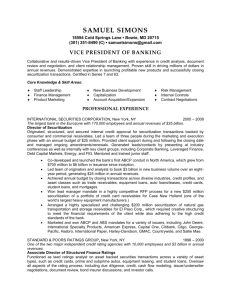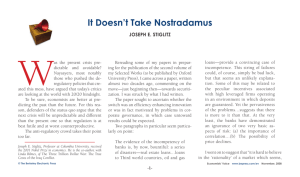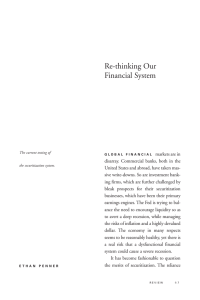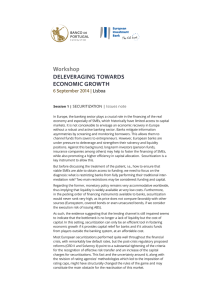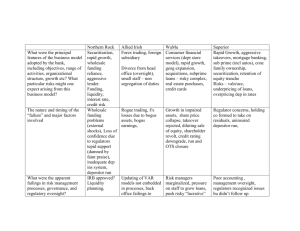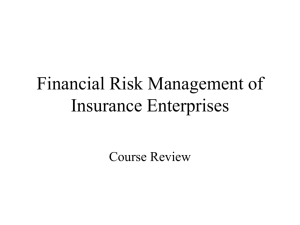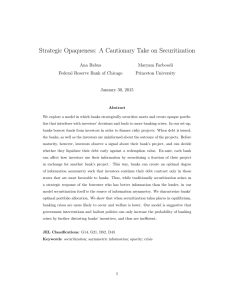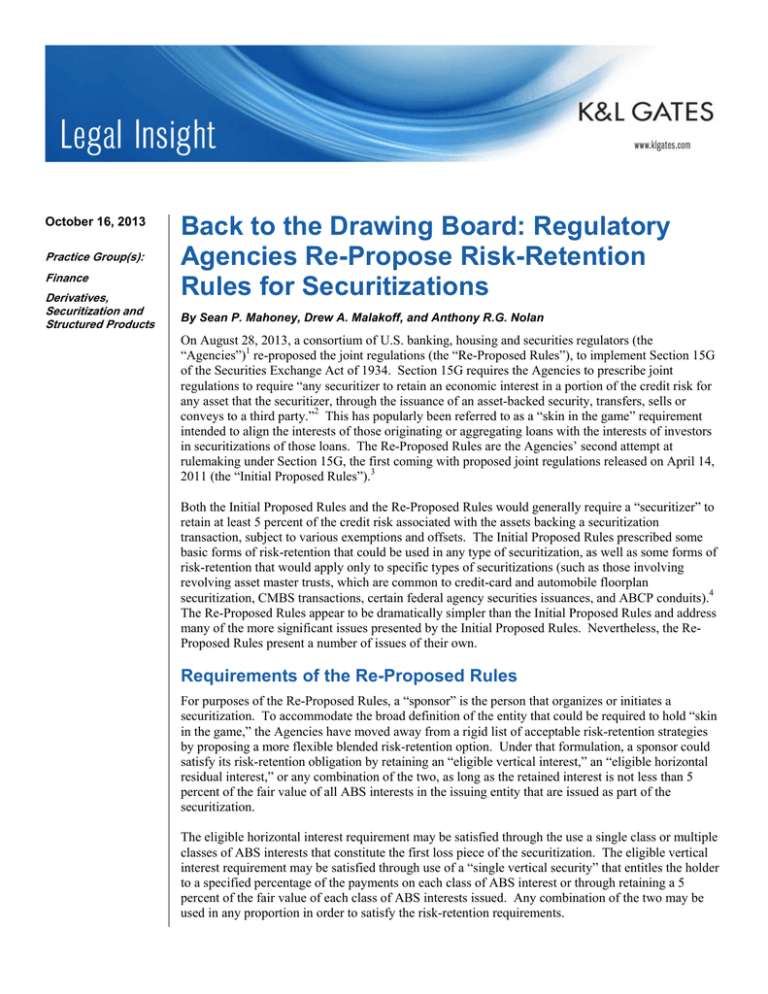
October 16, 2013
Practice Group(s):
Finance
Derivatives,
Securitization and
Structured Products
Back to the Drawing Board: Regulatory
Agencies Re-Propose Risk-Retention
Rules for Securitizations
By Sean P. Mahoney, Drew A. Malakoff, and Anthony R.G. Nolan
On August 28, 2013, a consortium of U.S. banking, housing and securities regulators (the
“Agencies”)1 re-proposed the joint regulations (the “Re-Proposed Rules”), to implement Section 15G
of the Securities Exchange Act of 1934. Section 15G requires the Agencies to prescribe joint
regulations to require “any securitizer to retain an economic interest in a portion of the credit risk for
any asset that the securitizer, through the issuance of an asset-backed security, transfers, sells or
conveys to a third party.”2 This has popularly been referred to as a “skin in the game” requirement
intended to align the interests of those originating or aggregating loans with the interests of investors
in securitizations of those loans. The Re-Proposed Rules are the Agencies’ second attempt at
rulemaking under Section 15G, the first coming with proposed joint regulations released on April 14,
2011 (the “Initial Proposed Rules”).3
Both the Initial Proposed Rules and the Re-Proposed Rules would generally require a “securitizer” to
retain at least 5 percent of the credit risk associated with the assets backing a securitization
transaction, subject to various exemptions and offsets. The Initial Proposed Rules prescribed some
basic forms of risk-retention that could be used in any type of securitization, as well as some forms of
risk-retention that would apply only to specific types of securitizations (such as those involving
revolving asset master trusts, which are common to credit-card and automobile floorplan
securitization, CMBS transactions, certain federal agency securities issuances, and ABCP conduits).4
The Re-Proposed Rules appear to be dramatically simpler than the Initial Proposed Rules and address
many of the more significant issues presented by the Initial Proposed Rules. Nevertheless, the ReProposed Rules present a number of issues of their own.
Requirements of the Re-Proposed Rules
For purposes of the Re-Proposed Rules, a “sponsor” is the person that organizes or initiates a
securitization. To accommodate the broad definition of the entity that could be required to hold “skin
in the game,” the Agencies have moved away from a rigid list of acceptable risk-retention strategies
by proposing a more flexible blended risk-retention option. Under that formulation, a sponsor could
satisfy its risk-retention obligation by retaining an “eligible vertical interest,” an “eligible horizontal
residual interest,” or any combination of the two, as long as the retained interest is not less than 5
percent of the fair value of all ABS interests in the issuing entity that are issued as part of the
securitization.
The eligible horizontal interest requirement may be satisfied through the use a single class or multiple
classes of ABS interests that constitute the first loss piece of the securitization. The eligible vertical
interest requirement may be satisfied through use of a “single vertical security” that entitles the holder
to a specified percentage of the payments on each class of ABS interest or through retaining a 5
percent of the fair value of each class of ABS interests issued. Any combination of the two may be
used in any proportion in order to satisfy the risk-retention requirements.
Back to the Drawing Board: Regulatory Agencies RePropose Risk-Retention Rules for Securitizations
A sponsor can offset the amount of retained interest that is held by a significant originator of loans in
the securitization against the sponsor’s risk-retention requirement. The offset must be in the same
proportion that the loans originated by the originator represent to the aggregate loans in the
securitization (measured by unpaid principal balance). The originator offset may only be applied
against originator originated loans that represent 20 percent or more of the aggregate loan balance in
the securitization. Additionally, a sponsor may only offset a risk-retention interest held by an
originator if that originator acquired its interest for cash or in exchange for the securitized assets. A
sponsor would need to have controls in place, and would need to monitor originators, as the sponsor
maintains responsibility for ensuring compliance with the risk-retention requirement. Where there are
multiple sponsors, the responsibility for retained risk could be allocated among the sponsors, but each
sponsor would be obligated to ensure compliance with the applicable risk-retention requirements.
Like the Initial Proposed Rules, the Re-Proposed Rules contain several exemptions to the riskretention requirements. The most-discussed of these exemptions are the zero risk-retention
requirements for securitizations that are backed by of qualifying assets and that and satisfy other
conditions (e.g., disclosures, certifications, and buy-back requirements).
Qualifying assets consist of residential mortgage loans, commercial mortgages, commercial real estate
loans, and automobile loans that in each case meet specified underwriting criteria. While qualifying
assets are not a new concept, having already been worked into the Initial Proposed Rules, the ReProposed Rules take into account the input of industry leaders in the origination of loans in identifying
more workable definitions for qualifying assets (in particular, there was much consternation
surrounding the definition of a qualifying auto loan under the Initial Proposed Rules, whose definition
has been altered significantly in response). Perhaps most importantly, not every asset in a
securitization will need to be a qualifying asset in order to take advantage of this exemption. The ReProposed Rules allow the securitizer to reduce their 5 percent risk-retention requirement by the ratio
of the combined unpaid principal balance of qualified assets bears to the total unpaid principal balance
of the assets in the pool.
Additionally, the Re-Proposed Rules exempt securitizations of seasoned loans from the risk-retention
requirements. The Agencies have taken the view that seasoned loans have had a sufficient period of
time to prove their performance. In a similar vein, prohibitions on the transfer of retained risk sunset
after a period of time equivalent to the seasoning period in the regulations. From a common sense
standpoint, securitizations backed by loans that have been paying down for longer substantial portions
of their life are less likely to have origination defects that an originator or sponsor of a securitization
could avoid during the underwriting process.
There are also other exemptions from the risk-retention requirements for certain categories of
transactions. In general terms, these include securitizations that are guaranteed or insured by the U.S.
government or a government-sponsored enterprise5 such as Fannie Mae, Freddie Mac, Ginnie Mae, or
Farmer Mac, securitizations that are sponsored by the FDIC as conservator or receiver and
securitizations that are issued or guaranteed by a state and certain student loan bonds. They also
include resecuritizations that are backed solely by servicing assets and tranches of ABS transactions
that adhere to the risk-retention requirements and structured as a single class of ABS pass-through
interests or are collateralized solely by servicing assets and first-pay classes of residential mortgagebacked securities that satisfy or are exempt from the risk-retention requirements, that are structured to
reallocate prepayment risk and not credit risk and that do not include inverse floaters or similarly
structured ABS interests.
2
Back to the Drawing Board: Regulatory Agencies RePropose Risk-Retention Rules for Securitizations
Additionally, the Re-Proposed Rules exempt ABS issued by regulated electric utilities that are backed
by stranded costs, transition property, system restoration property, and other types of property
specifically created or defined for regulated utility-related securitizations by state legislatures.
Specifically, the Re-Proposed Rules would exempt any securitization transaction where the ABS are
issued by an entity that is wholly owned, directly or indirectly, by an investor-owned utility company
that is subject to the regulatory authority of a state public utility commission or other appropriate state
agency. Additionally, ABS issued in an exempted transaction would be required to be secured by the
intangible property right to collect charges for the recovery of specified costs and such other assets of
the issuing entity.” 6 The Re-Proposed Rules would define “specified cost” to mean any cost
identified by a state legislature as appropriate for recovery through securitization pursuant to
“specified cost recovery legislation.”
Important Differences between the Initial Proposed Rules and
the Re-Proposed Rules
Although the Agencies have kept the basic structure of the risk-retention rules similar, there are some
significant differences between the Initial Proposed Rules and the Re-Proposed Rules. These rules
will cause issues for various securitization markets, which are as diverse as the markets themselves
are. CLOs, for example, will face different challenges than ABS backed by residential mortgage
loans. Despite many similarities to the Initial Proposed Rules, the Re-Proposed Rules reflect some
significant differences in approach from that reflected in the Initial Proposed Rules. Market
participants will need to be aware of some significant new wrinkles.
Definition of QRM
A key feature of the Initial Proposed Rules was an exemption from the credit risk-retention
requirement for securitized pools entirely backed by qualified residential mortgages (“QRMs”) that
are underwritten to specified requirements prescribed by regulation. While this feature has not
changed, the definition of a QRM has been vastly simplified by simply cross-referencing to the
definition of “qualified mortgage,” a very similar concept, under Section 129C of the Truth in Lending
Act and regulations promulgated thereunder. This change avoids the potential for increased
compliance burden and unintended consequences that would be present in any definition of QRM not
aligned with “qualified mortgage.”7
Premium Capture Cash Reserve Account and Fair Valuation
To the relief of many, the Re-Proposed Rules would eliminate the “premium capture reserve account.”
Under the Initial Proposed Rules, securitizers would have been required to establish a separate
“premium capture cash reserve account” to capture excess spread throughout the life of a transaction
until all ABS were paid in full. This was intended to prevent a securitization sponsor from using upfront profits of excess spread monetization to mitigate losses that might arise in tranches that it would
be required to retain.
Rather than retaining this feature, which was the subject of much consternation throughout the
industry, the Re-Proposed Rules provide that the 5 percent risk-retention requirement would be
calculated on the basis of fair value of the securitization determined in accordance with U.S. GAAP
rather than based on par value of tranches measured as of the pricing of the transaction. This change
effectively increases the value of the retained interest from what it would have been under the Initial
Proposed Rules. Owing to this change, the Re-Proposed Rules do not include a premium capture cash
3
Back to the Drawing Board: Regulatory Agencies RePropose Risk-Retention Rules for Securitizations
reserve account requirement. It is important to note that the methodology for calculating the fair value
will be required to be disclosed to investors.
Sales and Hedging of the Retained Risk
While both the Initial Proposed Rules and the Re-Proposed Rules permitted the credit risk to be
retained by the originator of the underlying assets under certain circumstances, the Initial Proposed
Rules would have prohibited the sponsor or originator from hedging the credit risk, pledging the
retained asset or interest as collateral for any obligation, or selling or transferring any retained asset or
interest to any person other than a majority-owned affiliate throughout the life of the securitization.
The Re-Proposed Rules retain that prohibition but significantly shorten the period of time during
which it is effective.
For securitizations where all securitized assets are residential mortgages, the prohibitions expire
beginning five years after the date of closing, after the total unpaid principal balance of the residential
mortgages has been reduced to 25 percent of the unpaid principal balance at closing, but in all cases,
not later than seven years after transaction closing. For other securitizations as well as transfers of the
horizontal residual interest in CMBS securitizations, the prohibitions on hedging referenced above
expire on the date that is the latter of (1) when the total unpaid principal balance of the securitized
assets that collateralize the transaction has been reduced to 33 percent of the original unpaid principal
balance at closing, (2) when the total unpaid principal obligations under the ABS interests issued
under the securitization transaction has been reduced to 33 percent of the unpaid principal obligations
of the ABS interests at closing, or (3) two years after the securitization transaction closing.
With respect to CMBS, the Re-Proposed Rules, similar to the Initial Proposed Rules, allow a thirdparty purchaser – typically referred to as a “B-piece buyer” – to acquire the retained risk in the form of
a first-loss piece horizontal slice of the securitization. However, under the Re-Proposed Rules, a Bpiece buyer or a sponsor that initially retained an eligible horizontal residual interest to transfer that
interest to a subsequent qualified third-party purchaser five years after the date of the securitization
closing.
This change reflects the Agencies’ acknowledgment that losses due to underwriting quality occur
early in the life of a securitization. Further along in the transaction, risk-retention will do little to
improve the underwriting quality of ABS, as most subsequent losses are due to events unrelated to the
underwriting process.
L-Shaped Structuring Flexibility/Removal of Representative Sample
The Initial Proposed Rules permitted a sponsor to comply with the risk-retention requirement by
retaining a pari pasu interest in a representative sample of assets that are materially similar to the
securitized assets and held on its balance sheet. This branch of the Initial Proposed Rules was
substantially similar to the rule applied by the FDIC to banks issuing securitizations over the last few
years. The representative sample approach would have favored securitization sponsors that have large
balance sheets and that do not rely on securitization for all of their funding needs. However, the
representative sample method of risk-retention set forth under the Initial Proposed Rules has been
removed entirely. Since the Re-Proposed Rules will supersede the old rule as applied by the FDIC,
banks which were making use of the representative sample method of risk-retention will need to adjust
their securitization strategies.
4
Back to the Drawing Board: Regulatory Agencies RePropose Risk-Retention Rules for Securitizations
However, securitizers will have increased flexibility in structuring their risk-retention as the horizontal
slice and the vertical slice, if used in the same transaction, are no longer required to be equal under the
Re-Proposed Rules. Under the Initial Proposed Rules, the vertical and horizontal slice needed to be
effectively equal. Securitizers under the Re-Proposed Rules may use any combination of horizontal
and vertical slices, allowing them much greater leeway in finding a structure that works for them.
Blended Pools
The Initial Proposed Rules did not allow the zero risk-retention option for qualified assets to apply
unless all of the assets underlying the securitization were qualifying assets. The Re-Proposed Rules
are more permissive, allowing a securitization sponsor to benefit from a proportional reduction of the
risk-retention requirement for homogenous pools that consist only in part of qualifying assets. The
Re-Proposed Rules would permit a securitizer to reduce its risk-retention requirement by the ratio of
the combined unpaid principal balance of qualified loans to the total unpaid principal balance of the
loans in the pool, with a floor of 2.5 percent risk-retention for any securitization that includes both
qualifying and non-qualifying assets. However, any non-qualifying assets would be subject to full
risk-retention requirements. An important limitation to this flexibility is that the blended exemption
described above would not apply to a securitization that includes mixed asset classes. Additionally, in
order to benefit from the risk-retention relief for blended pools the sponsor would be required to
disclose to investors a description of the qualifying and non-qualifying groups, how they differ and the
risk-retention calculation methodology.
CLOs
The treatment of CLOs was one of the more controversial aspects of the Initial Proposed Rules and
remains controversial in the Re-Proposed Rules. The Initial Proposed Rules did not distinguish CLOs
from true sale securitization, and, in the infamous footnote 42 of the Initial Proposed Rules, the SEC
suggested that the CLO manager was the sponsor and as such the party required to retain risk. In
response to comments that observed that CLO managers would typically not have the financial
capacity to hold risk-retention, the Re-Proposed Rules provide that for “open market CLOs” the riskretention requirement may be satisfied by the lead arrangers of loans purchased by the CLO rather
than by the CLO manager. An “open market CLO” is a CLO (1) whose assets consist only of senior,
secured syndicated loans constituting CLO-eligible loan tranches that are acquired directly in open
market transactions and of servicing assets, (2) that is managed by a CLO manager, and (3) that holds
less than 50 percent of its assets in loans syndicated by lead arrangers that are affiliates of the CLO or
originated by originators that are affiliates of the CLO. Pursuant to this option, the lead arranger is
defined as the institution that: (1) is active in the origination, structuring, and syndication of
commercial loans transactions and played a primary role in the structuring, underwriting, and
distribution on the primary market of the CLO-eligible loan tranche; (2) took an allocation of the
syndicated credit facility under the terms of the transaction that includes the CLO-eligible loan tranche
at least equal to the greater of 20 percent of the aggregate principal balance at origination or the
largest allocation of any syndication member at origination; and (3) is identified at the time of
origination in the credit agreement and inter-creditor documents. For CLOs that do not qualify for
treatment as open market CLOs, the CLO manager is still the “securitizer” and responsible for riskretention.
5
Back to the Drawing Board: Regulatory Agencies RePropose Risk-Retention Rules for Securitizations
Conclusion
The re-proposal of risk-retention rules reflects an acknowledgment of fundamental conceptual
shortcomings contained within the Initial Proposed Rules. While the Re-Proposed Rules certainly
make strides in addressing the concerns of commenters to the Initial Proposed Rules, there are wide
ranging implications for all transaction parties, which should be considered in determining the impact
of the Re-Proposed Rules.
Authors:
Sean P. Mahoney
sean.mahoney@klgates.com
+1.617.261.3202
Drew A. Malakoff
drew.malakoff@klgates.com
+1.212.536.4034
Anthony R.G. Nolan
anthony.nolan@klgates.com
+1.212.536.4843
Anchorage Austin Beijing Berlin Boston Brisbane Brussels Charleston Charlotte Chicago Dallas Doha Dubai Fort Worth Frankfurt
Harrisburg Hong Kong Houston London Los Angeles Melbourne Miami Milan Moscow Newark New York Orange County Palo Alto Paris
Perth Pittsburgh Portland Raleigh Research Triangle Park San Diego San Francisco São Paulo Seattle Seoul Shanghai Singapore Spokane
Sydney Taipei Tokyo Warsaw Washington, D.C. Wilmington
K&L Gates practices out of 48 fully integrated offices located in the United States, Asia, Australia, Europe, the
Middle East and South America and represents leading global corporations, growth and middle-market companies,
capital markets participants and entrepreneurs in every major industry group as well as public sector entities,
educational institutions, philanthropic organizations and individuals. For more information about K&L Gates or its
locations, practices and registrations, visit www.klgates.com.
This publication is for informational purposes and does not contain or convey legal advice. The information herein should not be used or relied upon in
regard to any particular facts or circumstances without first consulting a lawyer.
©2013 K&L Gates LLP. All Rights Reserved.
1
The Agencies that issued the Proposing Release are: the Board of Governors of the Federal Reserve System, the
Federal Deposit Insurance Corporation (the “FDIC”), the Office of the Comptroller of the Currency (the “OCC”), the
Securities and Exchange Commission (the “SEC”), the U.S. Department of Housing and Urban Development (“HUD”) and
the Federal Housing Finance Agency (“FHFA”). HUD and FHFA participated in the rulemaking only with respect to
provisions governing residential mortgage loan securitizations.
2
15 U.S.C. 780G(b).
3
Credit Risk-Retention, 76 Fed. Reg. 24090 (April 29, 2011) (the “Initial Proposing Release”).
6
Back to the Drawing Board: Regulatory Agencies RePropose Risk-Retention Rules for Securitizations
4
For our alert on the Initial Proposed Rules, please click here.
The exemption for government-sponsored enterprise securitizations is effective only while the government-sponsored
enterprises are in conservatorship.
6
The SEC regards the stranded cost legislation and the rate-setting authority as equivalent to a government guarantee.
Although stranded costs securitizations have not been a prominent feature of securitization markets since the early 2000s,
the immense strains to the utility business model caused by renewable energy technology and micro grids is likely to
make stranded costs legislation and concomitant securitization more prominent as a potential source of financing for the
utility industry.
7
For more information pertaining to the QRM aspects of the Re-Proposed Rules see our alert entitled, “Rulemaking
Dictating Loan Terms is Coalescing Around the CFPB’s Qualified Mortgage Standard, but the Future of Loans Outside of
this Standard Remains in Question.”
5
7

